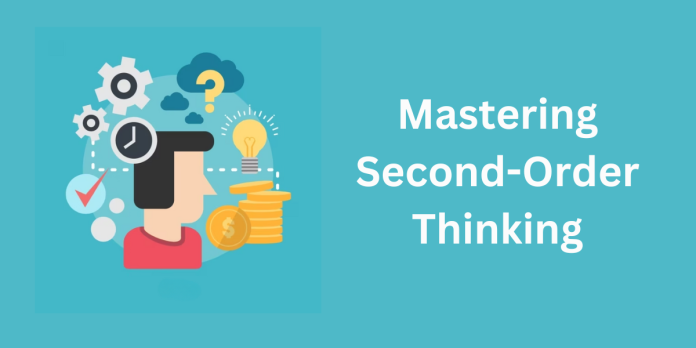Introduction
Navigating the intricate landscape of investing requires more than surface-level insights and immediate judgments. Second-order thinking, the ability to foresee and evaluate the consequences beyond the initial decision, is a critical skill that sets successful investors apart. In this blog post, we delve deeper into the significance of second-order thinking, examining its intricacies and offering a comprehensive guide on how to develop and master this indispensable cognitive tool.
What is Second-Order Thinking?
Before we explore the development of second-order thinking, it’s crucial to understand its essence. Coined as second-level thinking by Howard Marks, it transcends the simplicity of immediate reactions. While first-order thinking relies on quick, instinctive solutions to problems, second-order thinking demands a more deliberate, complex analysis, considering the potential consequences of actions over time. It involves thinking in terms of action and time, understanding that decisions have far-reaching effects.
The Difference Between First-Order and Second-Order Thinking:
Distinguishing between first and second-order thinking goes beyond Daniel Kahneman’s System One and System Two concepts. Howard Marks emphasizes that first-order thinking is superficial and simplistic, often leading to decisions that lack consideration of consequences. In contrast, second-order thinking requires a deeper exploration of possibilities, allowing investors to make informed decisions that extend beyond immediate gratification. Marks’ examples underscore how second-order thinkers can diverge from the crowd and make decisions based on a broader perspective.
Ray Dalio on Second-Order Thinking:
Ray Dalio, in his book Principles, provides valuable insights into the importance of recognizing higher-level consequences in decision-making. He suggests that individuals who overemphasize first-order consequences, while neglecting subsequent orders, often fall short of their goals. Dalio’s philosophy encourages looking beyond immediate temptations or barriers, recognizing that nature often presents choices with both positive and negative consequences.
How to Develop Second-Order Thinking:
Developing second-order thinking is a deliberate and proactive process that demands commitment and practice. Here’s a more detailed exploration of strategies to cultivate and enhance this essential cognitive skill:
- Question Everything:
Embrace a relentless curiosity by asking the “And What If” question. Don’t settle for the first answer or solution; instead, continue questioning until you have a comprehensive roadmap of possibilities. For instance, when evaluating a company with growing earnings, delve deeper into the reasons behind the growth—examining factors like revenue, expenses, tax rates, and share buybacks.
Read: What Are Corporate Actions in Share Market
- Involve Others:
Break free from the limitations of first-order thinking by involving others in your decision-making process. Seek outside views and new perspectives, as collaboration can introduce alternative viewpoints and enhance the depth of your analysis.
- Think in the Long-Term:
Harness the power of second-order thinking by looking beyond immediate results and considering the long-term impact of decisions. Evaluate potential short-term pains that may lead to long-term gains, aligning with the principles of value investing.
- Don’t Discount Other Options Too Quickly:
Keep all options on the table initially. Resist the temptation to dismiss alternatives hastily, as your first impression may not always be the most comprehensive or accurate one.
- Use Systems and Psychology:
Embrace the latticework of mental models, as championed by Charlie Munger. Develop frameworks based on systems thinking and psychological understanding to overcome biases and enhance decision-making. Consider various latticeworks such as accounting, biology, chemistry, physics, finance, history, and psychology.
Practicing Second-Order Thinking
While the strategies outlined above provide a roadmap, the key to mastering second-order thinking lies in persistent practice. Continuous refinement of these skills through real-world applications, learning from experiences, and adapting your approach over time will contribute to the development of this crucial cognitive tool.
Final Thoughts
Mastering second-order thinking is an ongoing journey that demands dedication and resilience. As Charlie Munger rightly notes, it’s not supposed to be easy. However, the rewards of this strategic approach to decision-making in the complex world of investing are invaluable. By embracing the challenges of second-order thinking, investors position themselves to navigate the uncertainties of the market with intelligence and foresight, ultimately achieving long-term success.


